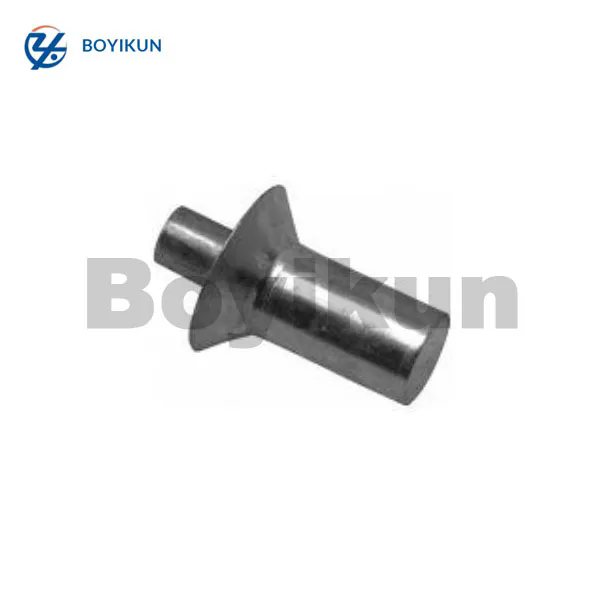Why Are Cold Forged Parts Essential in Modern Manufacturing?
2024-11-21
In the world of manufacturing, precision, strength, and efficiency are paramount. Cold forging, a technique that shapes metal at room temperature, has become an essential method for producing high-quality components used in a wide range of industries. But why are cold forged parts so important, and how do they stand out compared to other manufacturing processes?
In this blog, we’ll explore the significance of cold forged parts, their benefits, and why they have become a critical choice for manufacturers worldwide.
What Is Cold Forging and How Does It Work?
Cold forging is a process that shapes metal using high pressure, but unlike traditional forging, it is performed at or near room temperature. The metal is not heated but rather deformed by mechanical force. This results in parts that retain their original properties while being shaped into the desired form.
The cold forging process typically involves:
1. Metal Preparation: The raw material, usually a metal billet or wire, is chosen based on the specifications of the part to be produced.
2. Deformation: The material is then placed between dies in a press and shaped by force.
3. Finishing: After forming, the part may undergo additional processes such as trimming or coating to meet the desired final standards.
Cold forging is commonly used for producing a wide variety of parts, from simple fasteners to complex components used in automotive, aerospace, and industrial applications.
What Are the Key Benefits of Cold Forged Parts?
1. Enhanced Strength and Durability
Cold forging improves the strength of the material by aligning its grain structure during deformation. The resulting parts often have superior mechanical properties, such as higher tensile strength and resistance to wear and tear. These characteristics make cold forged parts ideal for use in demanding environments like automotive engines and machinery.
2. High Precision and Tight Tolerances
Cold forging allows manufacturers to produce parts with high dimensional accuracy and tight tolerances. The cold working process produces parts that are very close to their final shape, minimizing the need for additional machining and reducing the risk of errors. This precision is crucial in industries like aerospace, where even the smallest defect can have serious consequences.
3. Cost-Effectiveness
While the initial investment in cold forging equipment can be high, the process itself is cost-effective in the long run. Cold forged parts require fewer secondary operations like machining or grinding, reducing labor and material costs. Additionally, the process is highly automated, which boosts production efficiency and reduces manufacturing time.
4. Improved Surface Finish
Since the process is performed at room temperature, cold forging results in parts with smoother surface finishes compared to other methods such as casting. This reduces the need for extensive post-processing, saving both time and money. For industries requiring parts with minimal surface defects or aesthetic qualities, cold forging is an ideal option.
How Does Cold Forging Contribute to Sustainability?
As industries move toward more sustainable manufacturing practices, cold forging has gained attention for its environmental benefits. Some of the key aspects include:
1. Material Efficiency
Cold forging is a highly efficient process that minimizes material waste. The process uses near-net-shape forming, which means less material is wasted compared to other manufacturing methods like casting, where excess material must be removed. This helps reduce the environmental impact by lowering the amount of scrap produced.
2. Energy Efficiency
Unlike hot forging, which requires the material to be heated to high temperatures, cold forging consumes less energy. This makes it a more sustainable option, particularly for high-volume manufacturing, where energy costs can be significant.
3. Recyclability of Materials
Cold forged parts are often made from metals that are highly recyclable, such as steel and aluminum. This aligns with the growing demand for sustainable manufacturing practices that prioritize recycling and material reuse, further contributing to the process's eco-friendly reputation.
What Industries Rely on Cold Forged Parts?
Cold forged parts are widely used in many industries due to their strength, precision, and cost-effectiveness. Some of the key sectors that rely on cold forging include:
1. Automotive
Cold forging is commonly used to manufacture critical automotive components such as gears, crankshafts, and fasteners. The high strength and durability of cold forged parts are essential for the performance and safety of vehicles.
2. Aerospace
The aerospace industry demands parts with extremely high precision and strength to withstand harsh operating conditions. Cold forged components, such as engine parts, fittings, and structural components, play a critical role in ensuring safety and reliability.
3. Industrial Machinery
Cold forged parts are also crucial in the industrial machinery sector. Bearings, shafts, and other high-stress components benefit from the added strength and resistance to wear that cold forging provides, which helps extend the lifespan of equipment.
4. Oil and Gas
In the oil and gas industry, parts that can withstand extreme pressures and temperatures are essential. Cold forged components, such as valve bodies, pumps, and connectors, offer the strength and reliability needed in these challenging environments.
What Is the Future of Cold Forging?
As technology continues to evolve, cold forging processes are also advancing. Innovations in die design, material selection, and automation are making the process even more efficient and capable of producing complex parts. Additionally, the ongoing push for sustainability and cost reduction is driving further interest in cold forging as an environmentally friendly and efficient manufacturing method.
Furthermore, as industries like electric vehicles (EVs) and renewable energy expand, the demand for high-performance, durable components is expected to increase, further solidifying cold forging’s role in the manufacturing landscape.
Conclusion: Why Are Cold Forged Parts So Important in Modern Manufacturing?
Cold forged parts are indispensable to many industries due to their superior strength, precision, and cost-effectiveness. As the demand for high-performance and sustainable solutions grows, cold forging continues to be a leading manufacturing process. Its ability to produce durable, precise, and environmentally friendly components makes it an essential technique in the modern manufacturing world.
Whether in automotive, aerospace, or industrial machinery, cold forged parts are a crucial part of the machinery that powers the global economy. As technology progresses, it’s clear that cold forging will remain a key player in shaping the future of manufacturing.



